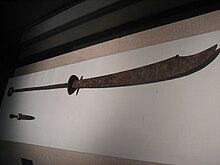This article relies largely or entirely on a single source. (August 2009) |
| Guandao | |||||||||||||
|---|---|---|---|---|---|---|---|---|---|---|---|---|---|
 Guandao, housed in the Inner Mongolia Museum | |||||||||||||
| Traditional Chinese | 關刀 | ||||||||||||
| Simplified Chinese | 关刀 | ||||||||||||
| Literal meaning | blade of Guan Yu | ||||||||||||
| |||||||||||||
| Yanyuedao | |||||||||||||
| Chinese | 偃月刀 | ||||||||||||
| Literal meaning | reclining moon blade | ||||||||||||
| |||||||||||||
A guandao is a type of Chinese polearm that is used in some forms of Chinese martial arts. In Chinese, it is properly called a yanyuedao (偃月刀; lit. "reclining moon blade"), the name under which it always appears[citation needed] in texts from the Song to Qing dynasties such as the Wujing Zongyao and Huangchao Liqi Tushi. It is comparable to the Japanese naginata and the European fauchard or glaive and consists of a heavy blade with a spike at the back and sometimes also a notch at the spike's upper base that can catch an opponent's weapon. In addition, there are often irregular serrations that lead the back edge of the blade to the spike. The blade is mounted atop a 1.5 to 1.8 m (4 ft 11 in to 5 ft 11 in) long wooden or metal pole and a pointed metal counterweight used to balance the heavy blade and for striking on the opposite end.
On modern versions, a red sash or tassel is attached at the joint of the pole and blade. Variations include having rings along the length of the straight back edge as found in the nine-ring guandao, having the tip curl into a rounded spiral as in the elephant guandao, or featuring a more ornate design as exemplified by the dragon head guandao. However, apart from the "elephant guandao", none of these variations seem to have historical ground.